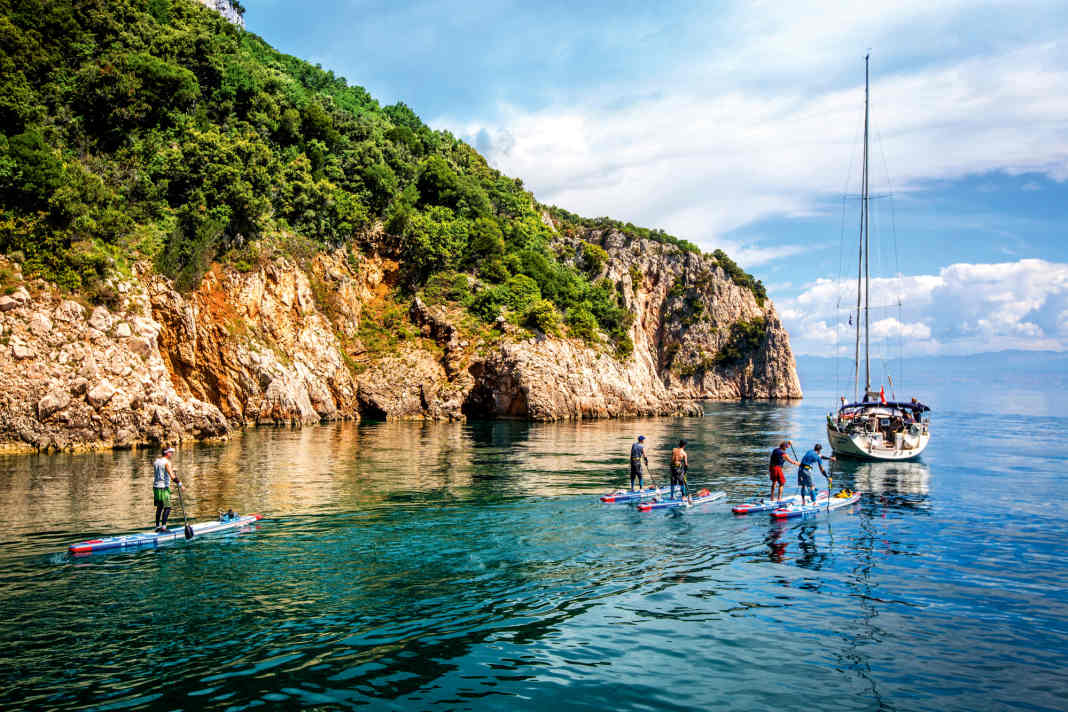





A SUP board can enrich life on board. It allows you to lie on the board somewhere and rock on small waves, do a few yoga exercises in the evening sun, romp around on it with the children or even explore two or three kilometres of unknown shore. However, the choice of boards available for this is huge. Hundreds of brands and probably over a thousand models make it seem like an unmanageable forest of boards for the uninitiated. Different designs, lengths, widths and thicknesses provide an almost infinite number of possible combinations.
But don't worry, SUP boards can be reduced to a manageable selection of types if you avoid the extremes for racing or white water. A SUP for on-board use - as a replacement or supplement to a dinghy or simply as an additional fun device for the summer - is subject to the same selection criteria as one for the local quarry pond. In both cases, a distinction is made between sleek touring boards, cosy bathing islands and robust family transporters.
Only the question of the type of construction, i.e. whether to opt for an inflatable board or one made of fibreglass, should be answered more quickly for use on board: Boards made from a foam core laminated with glass fibre and carbon fabric are already unwieldy for transport by car. On a boat, they are even more bulky, too heavy and too susceptible to damage - to the board and the boat.
Also interesting:
While the weight of iSUPs, i.e. inflatable boards, is only six and a half to around twelve kilograms, hardboards weigh up to 16 kilograms and more. The paddling characteristics may be slightly better, but the disadvantages in terms of storage and transport - and sometimes even on the water - clearly outweigh the advantages. This is why laminated boards only make up a single-digit percentage of all SUP boards sold.
The prices for hardboards, which start at around 1,200 euros and can even exceed 3,000 euros for touring or racing models, are hardly an incentive to buy. An inflatable board, on the other hand, is very easy to take with you on the boat, either rolled up and stowed in the back box or lashed to the railing ready to go at any time.
Almost all paddlers will find the right SUP model among just five standard sizes
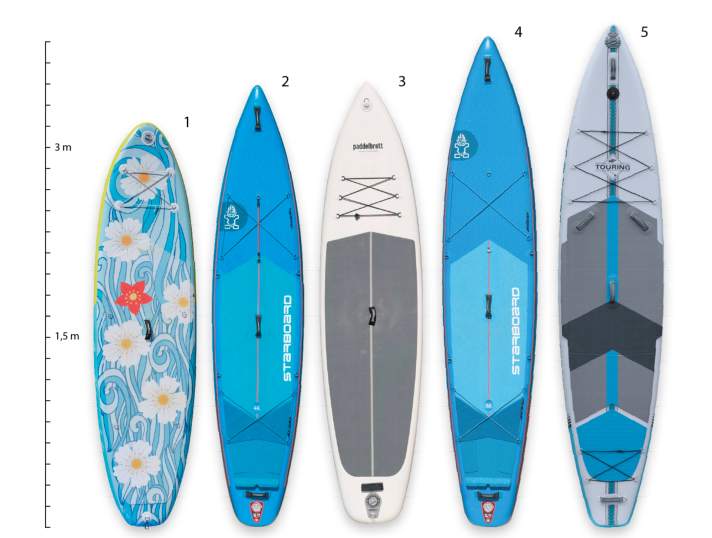
Only specialists for very specific requirements need more board models. At first glance, the differences between the five board types in the most important key data such as length and width seem rather minor. This is mainly because length and width in SUP sports are preferably specified in feet (1 foot = 30.5 cm) and inches (1 inch = 2.54 cm). The unit of measurement was adopted in the early days of stand-up paddling by surfers, who began paddling standing up, and has established itself internationally in the SUP scene. Hardly any paddler knows the length or width of their board in centimetres.
However, you can quickly get a feel for the most important size, the board width, even in the Anglo-American system: while professional SUP race boards are often only 23 inches or narrower, even light and sporty hobby paddlers should recognise 28 inches as the lower limit if they don't want to amuse their anchor neighbours on a floating balance beam.
As with all displacement hulls in paddle sports, a long length theoretically also enables a high top speed and a narrow width ensures low resistance when paddling. However, due to the higher centre of gravity on the SUP, you need more width for the necessary stability than, for example, when sitting in a canoe. And when the water is choppy or you're trying out SUP for the first time, kneeling on the SUP board provides an amazing increase in safety. The width of the board is crucial for stability. If you find the right size here, you've already made half the right purchase decision.
Most SUPs can be categorised into one of three length classes
Deviations of one to two inches are negligible and are hardly significant in practice. The three classes:
- A 10'6'' board is very manoeuvrable, but it also requires frequent changes of paddle side to maintain a stable course. These boards are also easy for children to steer
- A 11'6'' board runs more stable straight ahead and is already well suited for touring. Depending on the width, it can be designed as a comfortable all-rounder or as a sporty touring board.
- Predominantly 12'6'' long are classic touring boards that paddle very well in a straight line and offer plenty of space for luggage. Such longer boards are particularly suitable for regular tours of an hour or longer. However, children can hardly get round the bend on these SUP tankers. On the other hand, two or three kids can romp around on them at the same time.
The board width can be roughly divided into five categories of different suitability:
- The 29'' width is a narrow touring size. For sporty paddlers who see the tippy feeling as a challenge. Or for light touring paddlers weighing less than 70 kilograms.
- 30'' to 31'' wide is a typical touring board for paddlers weighing between 70 and 85 kilograms who have an average sense of balance.
- One 32'' width has an all-round board for relaxed touring paddling that can be used by the whole family. It is also suitable for tours with more luggage without sacrificing stability. 32 inches is also a common size for all-round boards (e.g. 10'6''-11'8'' x 32''). This board size covers the widest range of use.
- The 33'' width is often chosen for stable all-rounders (10'6'' x 33'') on which a parent with a child can also paddle. The width is also popular for yoga boards.
- 34'' to 36'' The wide boards are designed to be particularly stable and stable. Even if the paddler weighs over 90 kilos. Boards with a width of 36 inches are also suitable as expedition SUPs with a lot of luggage or for fishing.
Beware, boards with an overall very round outline, i.e. with a pointed bow and a narrow stern, can look like a one to two inch narrower model in terms of width category. They tend to be reserved for sporty paddle training. If you are unsure, it is better to choose a slightly chunkier board with the same maximum width that is not too narrow.
The biggest risk, especially with cheap boards, is that the material thickness is far too low
This quickly results in a banana shape. In the budget segment in particular, many boards were sold in four-inch thicknesses at times - which, from a serious point of view, only seems suitable for very light people under 60 kilograms. A solid measure for board thickness in all classes, however, is six inches (15 cm). From a physical point of view, thickness has a disproportionate effect on stiffness, namely to the third power. A board that is only five inches thick is already at a significant disadvantage compared to a standard six-inch construction, at the latest when higher loads come into play.
When stowing a board, there are a few tricks to save effort and space and also to protect the material. The first is to disassemble the equipment. After all, as easy as the spacious SUP rucksack supplied with the board, which may have really big off-road wheels, is to carry out of the shop - after it has effortlessly swallowed the pump, paddle and all kinds of accessories in its wide-opening gullet - some of these textile armoured cabinets are all the more bulky in the boot of a car and even more so on board. The rucksack straps constantly get caught somewhere, the wheels scrape the interior.
Small pack size thanks to clever details
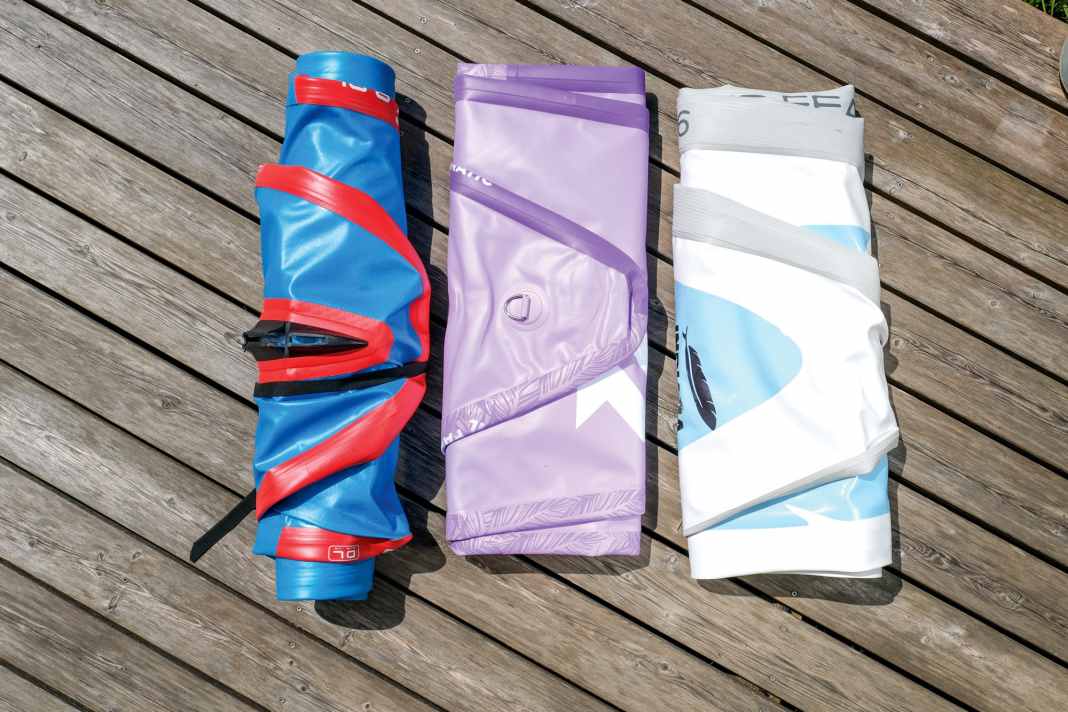


The board alone hardly takes up any more space than a summer sleeping bag. Compact models such as those from Starboard, Fanatic or Indiana score particularly highly in this respect (photo page 81 below). The "Pocket" and the "Feather" weigh just 6.5 kilos. The Starboard "Roll" 10'6'' also weighs just 7.6 kilograms and has a maximum diameter of just 25 centimetres and a length of 80 centimetres. It can be stowed in the furthest corner of the back box. A disused sail bag is all you need as a protective cover.
The pump and paddle are stored separately. If you are considering a higher-quality paddle than the aluminium paddles often supplied in the DIY set, this is best supplied in a case so that it can be stored without rattling.
Two measures can help to wrap the SUP roll as tightly as possible before stowing it away: Firstly, a board that has been "warmed up" for a few minutes on the jetty in the sun rolls much softer and tighter than a stiff PVC board at dawn. And what few paddlers realise: With the SUP pump, a board can not only be inflated, but also deflated. With the hose flanged to the pump's "deflate" connection, the air is sucked out like a vacuum packet of coffee beans.
On larger boats, you don't even need to inflate and deflate the board frequently. The board can simply be stored permanently on deck. Thinner, narrower and, above all, much lighter than any dinghy, it can be quickly lashed to the railing. At the same time, it hardly restricts the helmsman's view.
With the right equipment, a board can be noticeably easier to paddle
Every model has a central carrying handle, but not all of them are softly padded. Some manufacturers save a few cents here and only use a piece of tightly sewn, rigid webbing, which can constrict the fingers uncomfortably even on quite short carrying passages. Therefore, look for soft handle padding.
Additional carrying handles at the stern and bow also make it easier for children who are unable to carry the board on the centre handle on their own to at least make themselves independent with the SUP. And anyone who has to paddle around a spot on land that is not paddleable on tours with luggage - on a river, for example - will also be grateful for the multiple gripping options.
Board equipment: small but fine details that make all the difference
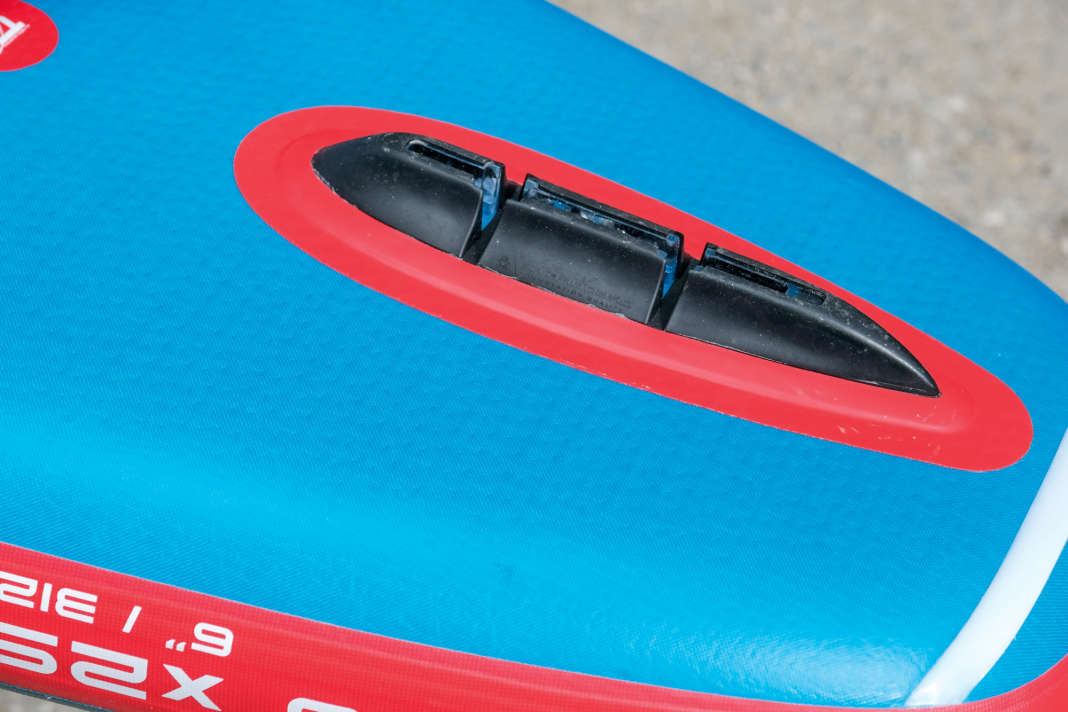





The luggage net is also sometimes skimped on. Some tensioning straps do not hold more than a small cosmetics bag. A missing net can be retrofitted if necessary: you can attach it yourself in 15 minutes using one of the numerous sets of eyelets, adhesive and elasticated straps available.
With a towing eye under the bow, the board can be easily moored or towed behind the boat for shorter distances. However, if you want to use it not only for paddling but also as a sun lounger, a yoga board is a good choice. In principle, these are wide, stable all-rounders (e.g. 10'6'' x 33''), where the deck has been neatly tidied up: without large nets, instead covered with a particularly large, soft covering. On days without yoga inspiration, these models are great all-round and family boards for paddling.
An additional fin to prevent drift, for example in the centre of the board, and a mast foot attachment on deck, on the other hand, enable completely different experiences. You can even try out the trendy wing surfing - without a foil - and such boards are also well suited for learning to windsurf. The length should not exceed 11'2'' and the width should not be less than 32 inches.
Finally, when it comes to processing, welded edges are a high-quality alternative to gluing. Fusion Technology is also often advertised, but in this case it is not the edges that are welded to the outer PVC cover instead of glued, but only the inner drop-stitch material (top right graphic), which saves weight but does not improve the durability of the board.
The paddle swings like a baton when travelling at speed and, in the best case, just as easily
Touring paddling follows a brisk pace. Even at a leisurely pace, you can paddle over 2,000 strokes in an hour, and in sport mode, a good double that number. This means that a difference of just 100 grams in paddle weight has a noticeable effect. An aluminium paddle from the complete set can weigh up to one kilo, and some paddles only float with an additional buoyancy chamber. The lightest carbon paddles, on the other hand, weigh half as much. But then you are often already in the price segment of a new board. But even the difference between a paddle weighing 950 or 750 grams is immediately noticeable to any newcomer - probably even more so than the difference between an expensive and a cheap board.
Three-piece paddles weighing less than 700 grams are available from around 180 euros. If the size still fits, a good paddle, like good tools, is a purchase for a decade or more.
The right tools
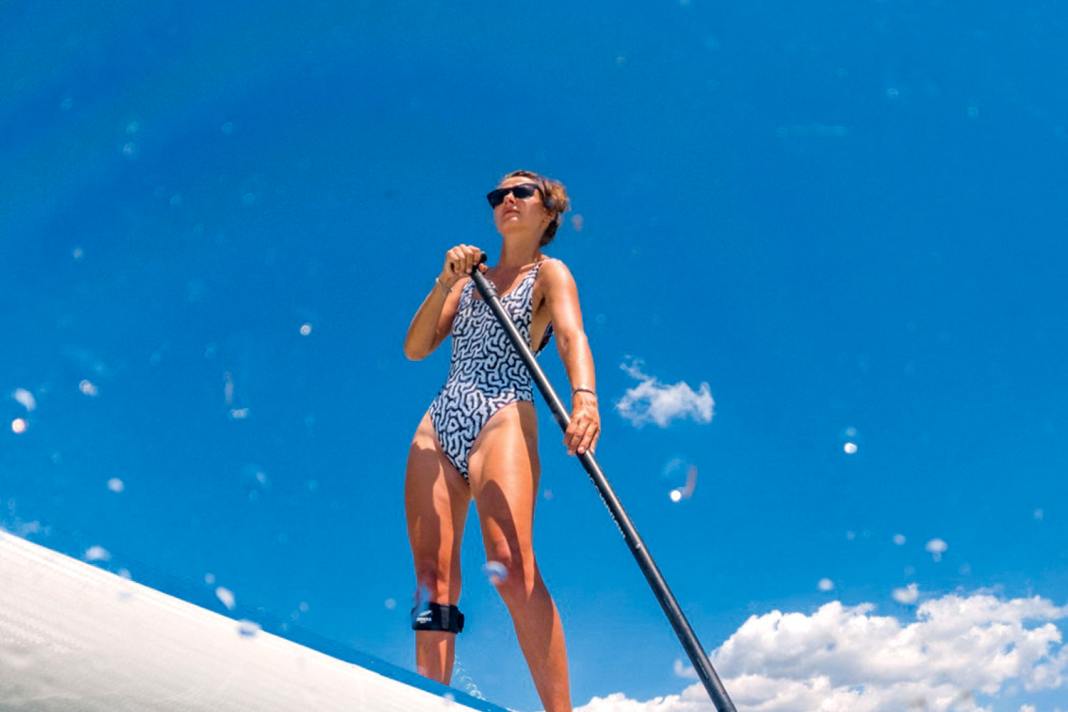





Blade size in particular has developed from large to ever smaller surfaces since the early days of SUP. Nowadays, nobody has to drag large paddle blades martially through the water. The paddling style has become faster, lighter and more energy-saving. Similar to the board dimensions, the blade area is also specified in square inches for almost all brands.
The range for a very light-handed to a really powerful paddling style extends between 80 and a maximum of 95 inch2 surface area. There is usually a good compromise for the whole family between 82 and 86-inch paddle blades.
Very inexpensive plastic blades, on the other hand, are still often made from outdated moulds and measure 100 inches2 or more, which - together with the high weight - makes them feel heavy and energy-sapping even on medium-length stretches. Effort that you can save yourself.
You can take a sporty approach to inflation - or use a practical electric pump
A pump is usually included with every board. However, very simple models are often found in inexpensive complete sets. A good pump, on the other hand, has two "gears": At the beginning, a lot of volume is pumped into the board when pulling and pushing. As the resistance increases and a lever is moved, pressure is then only built up when pushing, up to the 15 psi usually specified. Experience has shown that lighter riders can manage with significantly less pumping: Simply try 12 or 13 psi.
Small power stations
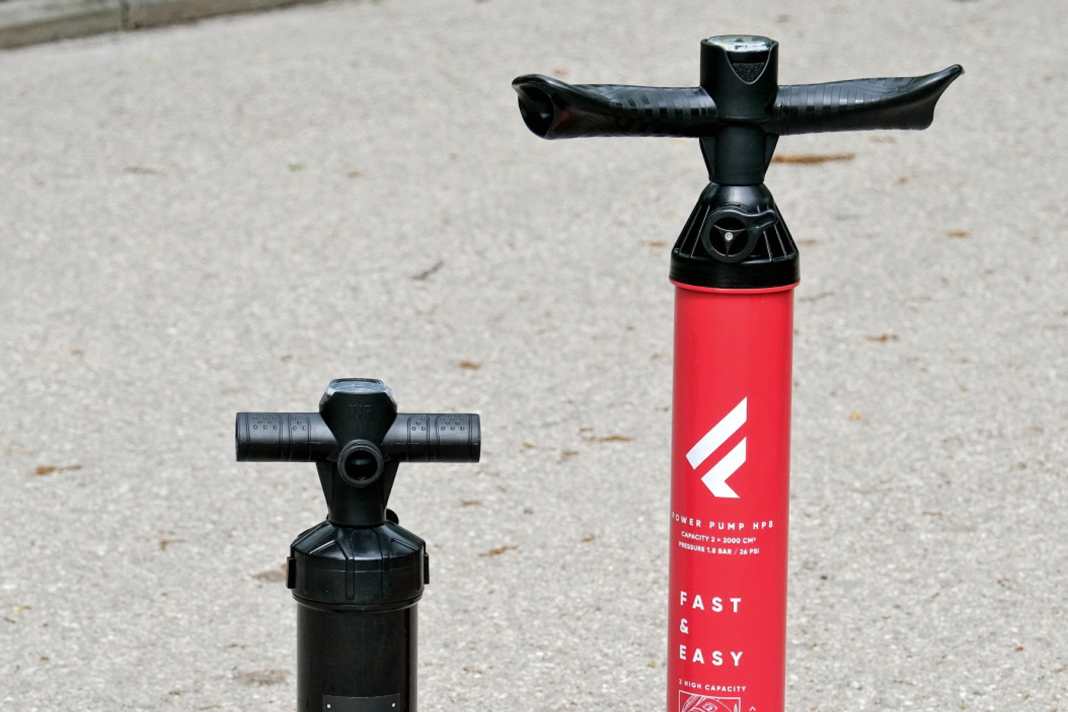


For limited storage space on board or for longer SUP tours, particularly compact pumps are a clever addition. The force required, which is mainly determined by the pump diameter, remains the same. However, inflation takes longer due to the shorter stroke.
SUP electric pumps are the last option to make work easier. Models without a battery run on 12 volts and are available from around 70 euros. Almost every pump takes at least ten minutes to pump a medium-sized board, including a decent compressor sound. But the convenience is unbeatable.
Detailed test reports of currently available products can be found for all SUP topics listed here (boards, paddles and also numerous electric pumps) on the Delius Klasing website at sup-mag.de.

